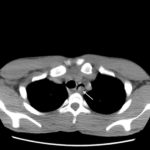Acute Dysphagia in a 25-Year-Old Male
History of present illness:
A 25-year-old male with a history of asthma presented to the emergency department (ED) with the sensation of food impaction in the mid-thoracic region and inability to swallow that began twenty minutes prior to arrival after eating chicken. Careful history revealed that the patient had several ED visits for similar episodes during his early childhood. Physical examination was benign with stable vitals. He had a clear oropharynx and normal breath sounds bilaterally. On cardiac auscultation, there was a regular rate and rhythm without appreciable murmur.
Significant findings:
After an unremarkable chest radiograph was obtained, a computed tomography (CT) scan of the chest was obtained due to possible co-ingestion of bones to rule out perforation. The CT scan demonstrated focal distention of the mid-esophagus due to an impacted food bolus (white arrow). An aberrant right subclavian artery (yellow arrow) was located just distal to the impaction site with partial compression of the esophagus (red arrow).
Discussion:
Arteria lusoria is an aberrant right subclavian artery. It is the most common embryologic abnormality of the aortic arch, occurring in 0.5% to 1.8% of the population.1 In this condition, the right subclavian artery arises directly off of the aorta, distal to the left subclavian artery, as opposed to the normal branching off the right brachiocephalic artery. While the majority of cases are asymptomatic, occasionally the artery will compress adjacent structures including the trachea and esophagus.2 This phenomenon was first described in 1794 by a London physician who remarked on a fatal case of “obstructed deglutition.”3 When the aberrant right subclavian artery causes compression and trachea-esophageal symptoms such as dysphagia, it is termed dysphagia lusoria.
The patient was diagnosed with dysphagia lusoria and given an intravenous bolus of glucagon with resolution of symptoms in one hour. He was able to tolerate liquids and solids without difficulty upon discharge. Management of dysphagia varies based on presentation and ability to tolerate oral intake. CT imaging may be useful in cases of recurrent food bolus impactions or high clinical suspicion for aerodigestive injury. Patients unable to swallow may require emergent subspecialist evaluation with additional imaging and endoscopic evaluation. Structural abnormalities such as dysphagia lusoria may ultimately require surgical intervention for definitive resolution of symptoms.
Topics:
Arteria lusoria, dysphagia, aberrant right subclavian artery.
References:
- Richardson JV, Doty DB, Rossi NP, Ehrenhaft JL. Operation for aortic arch anomalies. Ann Thorac Surg.1981; 31:426–432.
- Carrizo GJ, Marjani MA. Dysphagia Lusoria Caused by an Aberrant Right Subclavian Artery. Tex Heart Inst J. 2004;31(2):168-171.
- Bayford D. An account of a singular case of obstructed deglutition. Mem Med Soc Londo. 1794; 2:275-286.








